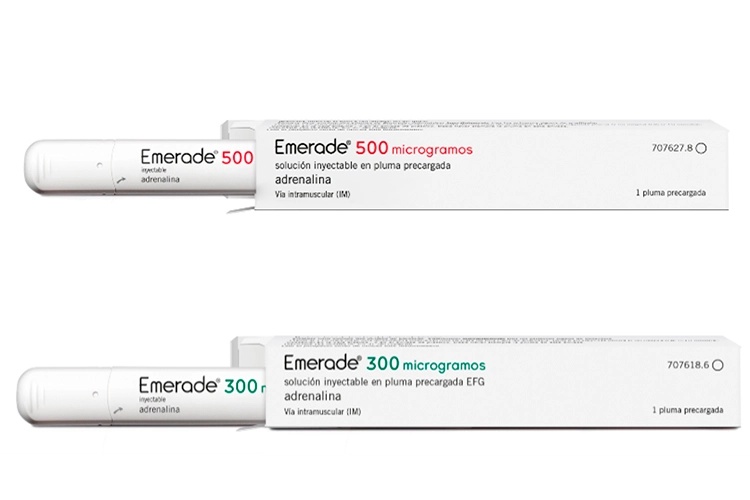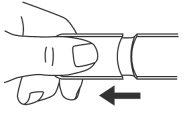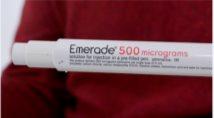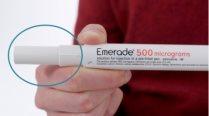

ЕМЕРАДЕ 300 мікрограмів розчин для ін'єкцій у попередньо заповненому шприц-ручці

Запитайте лікаря про рецепт на ЕМЕРАДЕ 300 мікрограмів розчин для ін'єкцій у попередньо заповненому шприц-ручці

Інструкція із застосування ЕМЕРАДЕ 300 мікрограмів розчин для ін'єкцій у попередньо заповненому шприц-ручці
Введення
Опис: інформація для користувача
Emerade 150 мікрограмів розчин для ін'єкції в попередньо наповненій пластиковій трубці EFG
Emerade 300 мікрограмів розчин для ін'єкції в попередньо наповненій пластиковій трубці EFG
Emerade 500 мікрограмів розчин для ін'єкції в попередньо наповненій пластиковій трубці
адреналін
Прочитайте уважно весь опис перед початком використання препарату, оскільки він містить важливу інформацію для вас.
- Збережіть цей опис, оскільки вам може знадобитися знову його прочитати.
- Якщо у вас виникли питання, проконсультуйтеся з вашим лікарем або фармацевтом.
- Цей препарат призначений тільки для вас і не слід давати його іншим людям, навіть якщо вони мають такі самі симптоми, як у вас, оскільки це може їм нашкодити.
- Якщо ви відчуваєте побічні ефекти, проконсультуйтеся з вашим лікарем або фармацевтом, навіть якщо це побічні ефекти, які не вказані в цьому описі. Див. розділ 4.
Зміст опису:
- Що таке Emerade і для чого він використовується
- Що потрібно знати перед початком використання Emerade
- Як використовувати Emerade
- Можливі побічні ефекти
- Зберігання Emerade
- Зміст упаковки та додаткова інформація
1. Що таке Emerade і для чого він використовується
Emerade - це пристрій для самоїн'єкції, який містить адреналін у розчині для ін'єкції в м'яз (внутрішньом'язово).
Адреналін протидіє падінню артеріального тиску при анафілактичних реакціях. Також він стимулює серце і полегшує дихання.
Emerade використовується як екстрене лікування при важких алергічних реакціях (анафілаксії) викликаних алергенами харчових продуктів, лікарських засобів, укусів або жалення комах і інших алергенів, а також у випадках, спричинених фізичними вправами або невідомими причинами.
2. Що потрібно знати перед початком використання Emerade
Ваш лікар пояснить, коли і як потрібно використовувати Emerade. Якщо ви не впевнені або маєте питання, зверніться до вашого лікаря.
Попередження та застереження
Emerade завжди можна використовувати під час алергічної екстреної ситуації. Якщо ви алергічні (гіперчутливі) до метабісульфіту натрію або до будь-яких інших компонентів Emerade, ваш лікар пояснить, у яких випадках потрібно використовувати Emerade.
Проконсультуйтеся з вашим лікарем перед початком використання Emerade, якщо у вас є:
- серцеве захворювання,
- високий артеріальний тиск,
- гіперфункція щитоподібної залози,
- цукровий діабет,
- пухлина надниркової залози,
- збільшення внутрішньоочного тиску (глаукома),
- зменшення функції нирок,
- прощення передміхурової залози,
- низький рівень калію або високий рівень кальцію в крові.
Якщо у вас є бронхіальна астма, ви можете мати підвищений ризик важкої алергічної реакції.
Людина, яка пережила епізод анафілаксії, повинна звернутися до лікаря та пройти тести на чутливість до речовин, яким вона може бути алергічною, щоб уникнути їх у майбутньому. Важливо пам'ятати, що алергія до однієї речовини може призвести до алергії до інших пов'язаних речовин.
Якщо у вас є алергія на якусь їжу, важливо перевірити склад усіх продуктів, які ви споживаєте (включаючи ліки), оскільки навіть невеликі кількості можуть викликати важкі реакції.
Також існує підвищений ризик появи побічних ефектів у людей похилого віку або вагітних.
Належить ретельно дотримуватися інструкцій з використання, щоб уникнути випадкової ін'єкції.
Emerade слід вводити внутрішньом'язово в зовнішню частину стегна. Не слід вводити в сідниці через ризик випадкової ін'єкції в вену.
Попередження
Випадкова ін'єкція в руки або ноги може призвести до зменшення кровотоку в ураженій ділянці. Якщо відбулася випадкова ін'єкція в цих ділянках, слід негайно звернутися до найближчої лікарні для отримання лікування.
Якщо у вас товста підшкірна жирова клітковина, існує ризик того, що одна доза Emerade може бути недостатньою. Це може збільшити потребу у повторній ін'єкції Emerade. Належить ретельно дотримуватися інструкцій з використання, вказаних у розділі 3.
Діти
Emerade не слід використовувати у дітей вагою менше 15 кг.
У випадку дітей вагою менше 15 кг не можна вводити дозу нижче 150 мікрограмів з достатньою точністю, і тому не рекомендується його використання, якщо тільки це не є потенційно смертельна ситуація та під медичним наглядом.
Використання у спортсменів:
Цей препарат містить адреналін, який може призвести до позитивного результату при тестуванні на допінг.
Використання Emerade з іншими лікарськими засобами
Повідомте вашого лікаря або фармацевта, якщо ви використовуєте, нещодавно використовували або можете використовувати будь-які інші лікарські засоби.
Це особливо важливо, якщо ви використовуєте будь-які з наступних лікарських засобів:
- Антидепресанти, такі як трициклічні антидепресанти або інгібітори моноамінооксидази (інгібітори МАО), оскільки ефекти адреналіну можуть збільшитися.
- Лікарські засоби для лікування хвороби Паркінсона, такі як інгібітори катехол-О-метилтрансферази (інгібітори КОМТ), оскільки вони можуть збільшити ефект адреналіну.
- Лікарські засоби, які можуть призвести до того, що серце буде мати нерегулярні скорочення (аритмії), такі як дигоксин і хінідин.
- Лікарські засоби, які називаються альфа- або бета-блокаторами для серцевих захворювань або порушень нервової системи, оскільки вони можуть зменшити ефект адреналіну.
Пацієнти з цукровим діабетом повинні ретельно контролювати рівень глюкози в крові після використання Emerade, оскільки адреналін може збільшити рівень глюкози в крові.
Вагітність і лактація
Якщо ви вагітні або перебуваєте у період лактації, вважаєте, що можете бути вагітною або плануєте завагітніти, проконсультуйтеся з вашим лікарем або фармацевтом перед використанням цього препарату.
Досвід використання адреналіну під час вагітності обмежений. Однак, якщо ви вагітні, не слід уникати використання Emerade в ситуації, коли ваше життя може бути під загрозою.
Ви можете годувати вашу дитину після використання Emerade.
Водіння транспортних засобів і використання машин
Мало ймовірно, що здатність водити транспортні засоби і використовувати машини буде порушена після введення ін'єкції адреналіну, але вона може бути порушена при важкій алергічній реакції. Якщо така здатність порушена, не слід водити транспортні засоби.
Emerade містить метабісульфіт натрію
У рідких випадках метабісульфіт натрію може призвести до важких реакцій гіперчутливості або труднощів з диханням (бронхоспазму). Якщо ви алергічні (гіперчутливі) до метабісульфіту натрію, ваш лікар пояснить, у яких випадках потрібно використовувати Emerade.
Emerade містить натрій
Цей препарат містить менше 1 ммоль натрію (23 мг) на дозу, тобто він практично не містить натрію.
3. Як використовувати Emerade
Впевніться, що ви завжди отримали інструктаж з використання Emerade, і дотримуйтесь точно інструкцій з використання Emerade, вказаних вашим лікарем. У разі сумнівів зверніться до вашого лікаря або фармацевта.
Перевірте термін придатності ваших автоін'єкторів адреналіну і попросіть вашого лікаря або медсестру призначити вам нові перед закінченням терміну придатності. Ін'єктори, термін придатності яких закінчився, можуть не функціонувати.
Emerade слід використовувати негайно, якщо з'являються ознаки або симптоми важкої алергічної реакції (анафілаксії). Реакції можуть виникнути через кілька хвилин після контакту з алергеном, і симптоми можуть бути, наприклад, висипанням на шкірі, жаром або набуханням. Найважчіші реакції також впливають на кровообіг і дихання.
Перед тим, як з'явиться необхідність використання Emerade, впевніться, що ви розумієте, у яких випадках потрібно його використовувати. Якщо ви маєте ризик анафілаксії, важливо завжди носити з собою дві пластикові трубки з адреналіном. Emerade слід зберігати в оригінальній коробці, хоча під час транспортування пацієнтом/опікуном прийнятно зберігати його в упаковці, спеціально розробленій для цього. Слід завжди носити трубку в цій упаковці, щоб забезпечити захист трубки і етикетки, яка показує, як її використовувати в екстреній ситуації. Збережіть завжди цю інформаційну брошуру в футлярі.
Дозування
Дозу визначить ваш лікар, який підбирає дозу індивідуально, наприклад, залежно від вашої ваги.
Дорослі
Дорослі з вагою менше 60 кг
Звичайна доза становить 300 мікрограмів
Дорослі з вагою більше 60 кг
Звичайна доза становить 300-500 мікрограмів
Діти та підлітки
Не рекомендується використання Emerade 500 мікрограмів у дітей.
Діти вагою 15-30 кг
Звичайна доза становить 150 мікрограмів.
Діти вагою більше 30 кг
Звичайна доза становить 300 мікрограмів.
Підлітки вагою більше 30 кг
Слід дотримуватися рекомендацій, вказаних для дорослих.
Як вводити Emerade
Слід ретельно дотримуватися інструкцій з використання, щоб уникнути випадкової ін'єкції.
Рекомендується, щоб ваші родичі, опікуни або вчителі також отримали інструктаж з правильного введення Emerade
Emerade слід використовувати тільки шляхом ін'єкції в зовнішню частину стегна при перших ознаках важкої алергічної реакції. Ін'єкція вводиться шляхом натискання на Emerade проти стегна. Її можна вводити через одяг. Не слід вводити в сідниці.
Якщо пластикова трубка з адреналіном Emerade не активується, негайно слід зробити повторну спробу, використовуючи більшу силу натискання на трубку проти місця ін'єкції.
Якщо це не вдається, слід негайно перейти до використання другої трубки.

- Видаліть кришку.
 Помістіть Emerade проти зовнішньої частини стегна під кутом 90 градусів і натисніть сильно, щоб захист ігли відійшов. Ви почуєте клацання, коли пристрій активується і ігла проникне в стегно.
Помістіть Emerade проти зовнішньої частини стегна під кутом 90 градусів і натисніть сильно, щоб захист ігли відійшов. Ви почуєте клацання, коли пристрій активується і ігла проникне в стегно.
і
 Утримуйте Emerade повністю натиснутим проти стегна протягом 5 секунд. Після цього легенько масажуйте місце ін'єкції.
Утримуйте Emerade повністю натиснутим проти стегна протягом 5 секунд. Після цього легенько масажуйте місце ін'єкції.
- Шукайте медичну допомогу негайно.
Ігла Emerade захищена до, під час і після ін'єкції.
Коли ін'єкція завершена, захист ігли Emerade стає видимим довшим, і поршень видно у вікні огляду при піднятті етикетки.
Ключові повідомлення для пацієнтів:
- Іноді одна доза адреналіну не достатня для повного протидії ефектам важкої алергічної реакції. Через це ваш лікар призначить вам дві пластикові трубки Emerade.
- Якщо ваші симптоми не покращились або погіршились у течение 5-15 хвилин після першої ін'єкції, ви або людина, з якою ви перебуваєте, повинні введення другу. Через це слід завжди носити з собою дві пластикові трубки Emerade.
- Emerade призначений як екстрене лікування. Негайно після використання Emerade завжди слід шукати медичну допомогу. Попросіть когось, щоб він залишився з вами, поки не прибуде швидка допомога, на випадок, якщо ви знову почуєтеся погано.
- Подзвоніть за номером 112, викличте швидку допомогу та повідомте, що це випадок 'анафілаксії',навіть якщо здається, що симптоми покращились. Вам потрібно буде відвідати лікарню для спостереження або отримання додаткового лікування, якщо це необхідно. Це пов'язано з тим, що певний час після цього реакція може повторитися. Візьміть з собою використану трубку.
- Поки ви чекаєте на швидку допомогу, слід лежати з піднятими ногами, якщо тільки ця позиція не заважає вам дихати, в якому випадку слід сідати прямо.
- Пацієнти, які втратили свідомість, повинні бути розміщені на боці в позиції відновлення.
Після використання пластикової трубки Emerade згідно з інструкціями пацієнт може перевірити, чи активувалась трубка. Зображення нижче (Фіг.1-Фіг.2) стосуються всіх доз Emerade (150 мікрограмів, 300 мікрограмів і 500 мікрограмів).
Пластикова трубка Emerade, яка не була використана (до активації), має захист ігли в нормальному положенні (Фіг. 1).

Фіг. 1.
Пластикова трубка Emerade, яка була активована, має захист ігли, який вийшов (Фіг. 2).

Фіг. 2
Якщо захист ігли не вийшов, трубка не була активована.
Пластикова трубка Emerade, яка була активована і успішно ввела дозу адреналіну, показуватиме кольоровий поршень у вікні огляду (яке відкривається при піднятті етикетки на трубці):
150 мікрограмів: жовтий
300 мікрограмів: зелений
500 мікрограмів: синій.
Якщо вікно огляду продовжує показувати прозору рідину (розчин адреналіну), трубка не ввела правильно дозу адреналіну. Стрілка на етикетці трубки показує, де можна підняти етикетку, щоб відкрити вікно огляду.
Не видаліть кришку, якщо тільки не потрібно вводити ін'єкцію.
Після ін'єкції може залишитися частина рідини в автоін'єкторі. Автоін'єктор не можна повторно використовувати.
Є автоін'єктори без ігли (трубки для демонстрації), доступні для навчання.
Будь ласка, проконсультуйтеся з вашим лікарем.
Якщо ви використали більше Emerade, ніж потрібно
Якщо була введена більша доза або якщо Emerade був випадково введений в кровоносну судину або в руку, слід негайно шукати медичну допомогу.
Ваш артеріальний тиск може різко підвищитися. Передозування може призвести до раптового підвищення артеріального тиску, нерегулярного серцебиття і накопичення рідини в легенях, що може утруднити дихання.
У разі передозування або випадкового прийому внутрішньо зверніться негайно до вашого лікаря або фармацевта або подзвоніть до служби токсикологічної інформації, телефон 915620420, вказавши назву препарату та кількість, прийняту.
Якщо у вас є будь-які інші питання щодо використання цього продукту, зверніться до вашого лікаря або фармацевта.
4. Можливі побічні ефекти
Як і всі лікарські засоби, цей препарат може призвести до побічних ефектів, хоча не всі люди їх відчувають.
Наступні побічні ефекти базуються на досвіді використання адреналіну, хоча їх частота не може бути оцінена:
- серцево-судинні проблеми, такі як швидке і нерегулярне серцебиття, біль у грудній клітці,
- підвищення артеріального тиску, звуження кровоносних судин,
- потіння,
- нудота, блювота,
- утруднення дихання,
- головний біль, головокружіння,
- слабкість, тремор,
- тривога, галюцинації,
- притуплення, зміни у значеннях крові, такі як підвищення рівня цукру в крові, зниження рівня калію та підвищення кислотності
Повідомлення про побічні ефекти
Якщо ви відчуваєте будь-які побічні ефекти, зверніться до вашого лікаря або фармацевта, навіть якщо це побічні ефекти, які не вказані в цьому описі. Ви також можете повідомити про них безпосередньо через систему фармакологічного нагляду за лікарськими засобами для людини https://www.notificaRAM.es
Повідомляючи про побічні ефекти, ви можете допомогти надати більше інформації про безпеку цього препарату.
5. Зберігання Emerade
Тримайте цей препарат поза досяжністю дітей.
Зберігайте в захисній пластиковій упаковці, в якій він поставляється. Пластикова упаковка, яка містить трубку/трубки, може бути збережена в зовнішній коробці.
Зберігайте при температурі нижче 25 °C. Не заморожуйте.
Не використовуйте цей препарат після закінчення терміну придатності, який вказаний на етикетці та зовнішній коробці. Термін придатності - останній день місяця, який вказаний. Після закінчення терміну придатності викиньте Emerade і замініть його на новий. Періодично перевіряйте розчин через вікно огляду, піднявши етикетку, щоб переконатися, що розчин залишається прозорим і безколірним. Не використовуйте цей препарат, якщо ви помітили, що розчин змінив колір або містить осад.
Перевіряйте автоін'єктор, якщо він впав. Замініть його, якщо ви помітили будь-які пошкодження або витік.
Лікарські засоби не слід викидати в каналізацію або сміттєві контейнери. Віддавайте упаковки та лікарські засоби, які вам не потрібні, в пункт збору SIGRE в аптеці. У разі сумнівів зверніться до вашого фармацевта, щоб дізнатися, як позбутися упаковок та лікарських засобів, які вам не потрібні. Таким чином, ви допоможете захистити навколишнє середовище.
6. Зміст упаковки та додаткова інформація
Склад Emerade
Активний інгредієнт - адреналін у формі тартрату.
Emerade 150 мікрограмів випускає 150 мікрограмів адреналіну в 0,15 мл розчину.
Emerade 300 мікрограмів випускає 300 мікрограмів адреналіну в 0,3 мл розчину.
Emerade 500 мікрограмів випускає 500 мікрограмів адреналіну в 0,5 мл розчину.
Інші компоненти: хлорид натрію, метабісульфіт натрію (E223), едетат динатрію, хлоридна кислота та вода для ін'єкційних препаратів.
Вигляд Emerade та вміст упаковки
Emerade - це автоін'єктор, який випускає одну дозу адреналіну. Emerade містить прозорий та безбарвний розчин для ін'єкції всередині скляної шприци. Emerade не містить латексу.
Пристрій являє собою білий циліндр із захисником, який покриває голку, та механізмом спуску.
Довжина голки, що виступає:
Emerade 150 мікрограмів: 16мм
Emerade 300 мікрограмів та 500 мікрограмів: 23мм.
Розміри упаковки: 1 або 2 попередньо завантажені шприци.
Можливо, не всі розміри упаковки будуть реалізовані.
Власник дозволу на реалізацію та відповідальна особа за виробництво
Власник
PharmaSwiss Ceská republika s.r.o.
Янковцока 1569/2с, 170 00 Прага 7.
Чеська Республіка.
Відповідальна особа за виробництво
Rechon Life Science AB
Солдатторпсвеген 5, SE-216 13 Лімгамн.
Швеція
Дата останнього перегляду цієї інструкції: Грудень 2021
Детальна та оновлена інформація про цей препарат доступна на сайті Державного агентства лікарських засобів та медичних продуктів (AEMPS)http://www.aemps.gob.es/
Ви можете отримати детальну та оновлену інформацію про цей препарат, скануючи код QR, включений до інструкції, за допомогою свого мобільного телефону (смартфона). Також ви можете отримати доступ до цієї інформації за наступною адресою інтернету:
https://cima.aemps.es/info/80146
https://cima.aemps.es/info/80147
https://cima.aemps.es/info/80149


Скільки коштує ЕМЕРАДЕ 300 мікрограмів розчин для ін'єкцій у попередньо заповненому шприц-ручці в Іспанії у 2025 році?
ЕМЕРАДЕ 300 мікрограмів розчин для ін'єкцій у попередньо заповненому шприц-ручці коштує в середньому 42.09 євро у грудень, 2025 році. Ціна може змінюватися залежно від регіону, аптеки та наявності рецепта. Рекомендуємо перевіряти актуальну вартість у місцевих аптеках або через онлайн-сервіси.
- Країна реєстрації
- Середня ціна в аптеках42.09 EUR
- Доступність у аптекахПроблеми з постачанням
- Діючі речовини
- Потрібен рецептТак
- Виробник
- Інформація є довідковою і не є медичною порадою. Перед прийомом будь-яких препаратів обов'язково проконсультуйтеся з лікарем. Oladoctor не несе відповідальності за медичні рішення, прийняті на основі цього контенту.
- Альтернативи до ЕМЕРАДЕ 300 мікрограмів розчин для ін'єкцій у попередньо заповненому шприц-ручціФорма випуску: РОЗЧИН ДЛЯ ІН'ЄКЦІЙ, 1 мг/10 млДіючі речовини: epinephrineВиробник: Laboratoire AguettantПотрібен рецептФорма випуску: РОЗЧИН ДЛЯ ІН'ЄКЦІЙ, Адреналін основа 1 мг/млДіючі речовини: epinephrineВиробник: B Braun Medical S.A.Потрібен рецептФорма випуску: РОЗЧИН ДЛЯ ІН'ЄКЦІЙ, 1 мг/млДіючі речовини: epinephrineПотрібен рецепт
Аналоги ЕМЕРАДЕ 300 мікрограмів розчин для ін'єкцій у попередньо заповненому шприц-ручці в інших країнах
Найкращі аналоги з тією самою діючою речовиною та терапевтичним ефектом.
Аналог ЕМЕРАДЕ 300 мікрограмів розчин для ін'єкцій у попередньо заповненому шприц-ручці у Польща
Аналог ЕМЕРАДЕ 300 мікрограмів розчин для ін'єкцій у попередньо заповненому шприц-ручці у Україна
Лікарі онлайн щодо ЕМЕРАДЕ 300 мікрограмів розчин для ін'єкцій у попередньо заповненому шприц-ручці
Консультація щодо дозування, побічних ефектів, взаємодій, протипоказань та поновлення рецепта на ЕМЕРАДЕ 300 мікрограмів розчин для ін'єкцій у попередньо заповненому шприц-ручці – за рішенням лікаря та згідно з місцевими правилами.










